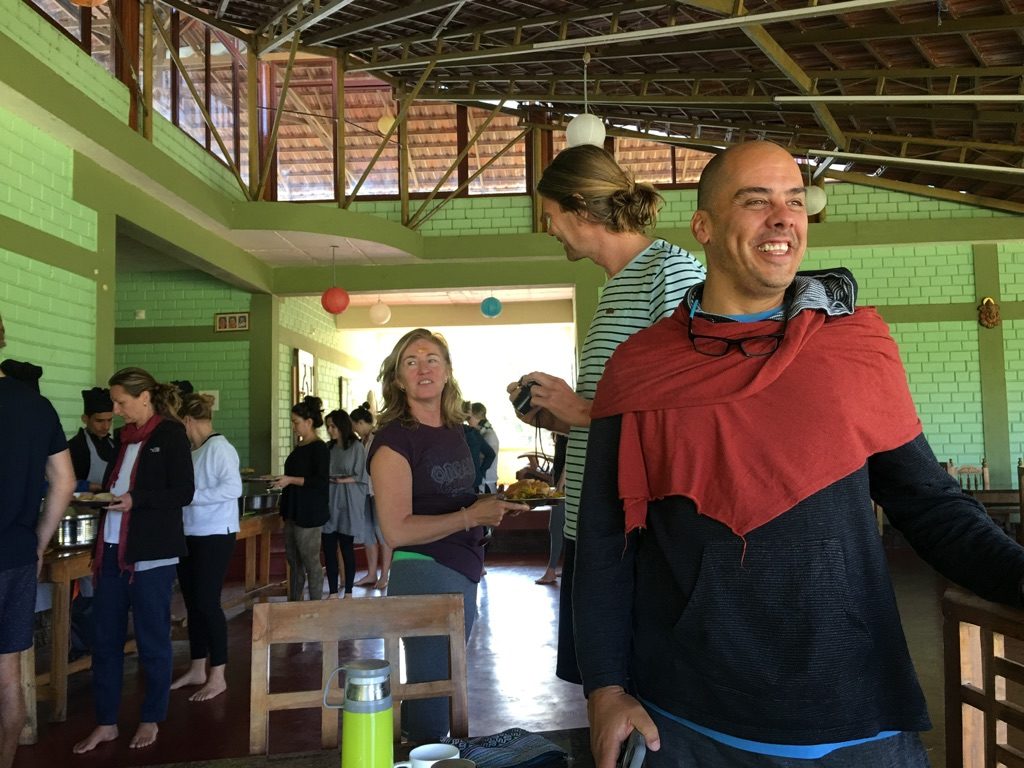Notice when to pause, how to avoid overeating, and a trick to identify actual signs of hunger

When I was in India this winter (2018) for Ayurvedic treatments to adjust my Vata imbalance, I learned a lot about my body and how different foods affect my system. Ayurveda is the 5000-year-old ancient Indian science of wellness, which helps us to learn what our natural temperament is, as well as our condition.
When we understand our natural temperament, we can understand in a felt sense way what our individual balance is. When we learn what balance is for us, we can identify imbalance quickly, and do our practices to come back into balance.
New Sensations you may experiences after Panchakarma or Ayurvedic treatment
I’m experiencing a lot of new sensations and awarenesses in my belly and my mind that I was not noticing or aware of before I went for a
I’ll get deeper into the principles of Ayurveda in future posts. But here I want to share some in-the-moment AHA’s I am having right now about what I eat, how I eat, and what feels good for my wellness and in my body.
Here are two new body awarenesses, and practices I have developed after Ayurvedic Treatment:
- Noticing when to pause to become aware of fullness and how to avoid overeating
- How to practice noticing if you’re actually hungry or if just overriding signs of hunger

(1) I notice a subtle disinterested feeling when I’ve eaten a certain amount of food. I am noticing that, and taking it as a cue for a moment of pause.
Like any machine – whether it produces candy or digests food – there are certain intake limits that the machine requires to operate at in its ideal functioning.
When the machine – your digestive system or any other system – reaches a processing limit, that machine needs to pause its intake and focus on its processing. It does this so it can processes what’s already in the tank, and have as much space as needed to process what it already has inside it.
The digestive tract is the same as any other system. We need to practice pausing for optimal processing.
When we reach an intake limit, pausing and allowing what is already in our system to digest – without adding more input – is fundamental. This is how we can practice not overeating, and not undereating.
We allow ourselves more time to notice what’s happening in our bodies, while being undistracted (aka. not looking at your phone while eating).
This allows the system to digest what we are already digesting – and to update us with more information on whether we need to take more in, pause for longer, or stop intake because the system is complete.
The subtle disinterest I am now aware of experiencing is an indication of my reaching a certain intake limit, and my system requesting a break from receiving more input, to allow for optimal processing.
My understanding of these subtle cues allows me to practice eating in a way that is respectful to my
When I pause, I can process physically, and also cognitively, so that what I take in is exactly appropriate to what my body needs for optimal functioning.
(2) I practice tuning in to my belly feeling, so that I notice when I am hungry. I stop eating when I feel satisfied within my body.

This is not as simple as it sounds!
When I got to India, after traveling around Thailand and eating lots of delicious foods, I was accustomed to eating past the point of comfort.
When I’m at work back home, sometimes I skip
Neither eating too much nor waiting too long to eat gives your body proper nutrition to function optimally.
We have complex nervous systems, and in broad strokes our bodies have two distinct modes that we can operate in.
- Fight or flight – this is sympathetic nervous system activation
- Rest and digest – this is parasympathetic nervous system activation
For a healthy nervous system we need to be able to move easefully between parasympathetic and sympathetic activation and release.
These are two intricate systems and how they operate, activate and release will be explored in many more posts. For our purposes here, the point to be made is:
We rarely notice the signs of hunger when our sympathetic nervous system is activated, and it’s very hard for us to eat well when our system is in that state of activation.
Jenny Bloom
What is the connection between sympathetic nervous system activation and not noticing when you are hungry?
Well, have you ever been at work and noticed that it’s 3 pm and you haven’t eaten lunch (or maybe breakfast) yet, and your starving, and also have no idea what to eat?
I have, many, many times.
How does that happen? And what is happening in your system when that does happen?
Well, when we are busy at work, solving problems, dealing with challenges, and in the focused part of
When our systems are not trained to move easefully between sympathetic and parasympathetic activity, we don’t know to listen for the signs that we need to take a break, that we are hungry, or tired, or upset. We tend to ignore them or suppress even feeling them at all.
Yoga is a practice that helps us learn to feel inside the body, and practice balancing our system.
The tools of yoga, are deprogramming, reprogramming, physical poses, breathwork, sense withdrawal, focused concentration, effortless concentration
Training in yoga can help to teach our bodies and our minds to pause, settle and take stock of what’s going on inside. Learning it on the mat helps us to practice off the mat.
When we learn what balance feels like, we can begin to identify imbalance, and use the tools of yoga and Ayurveda to bring our systems back into balance.
text